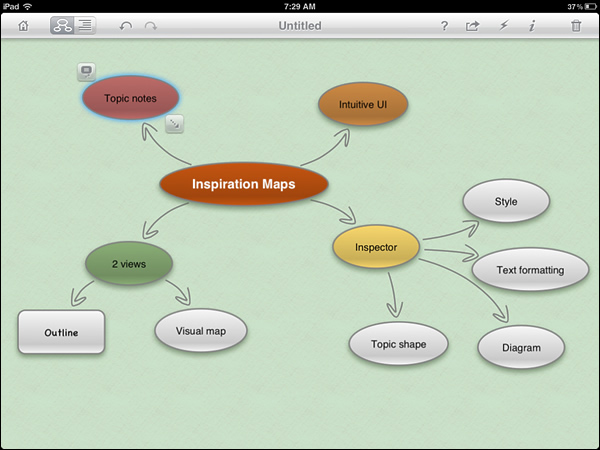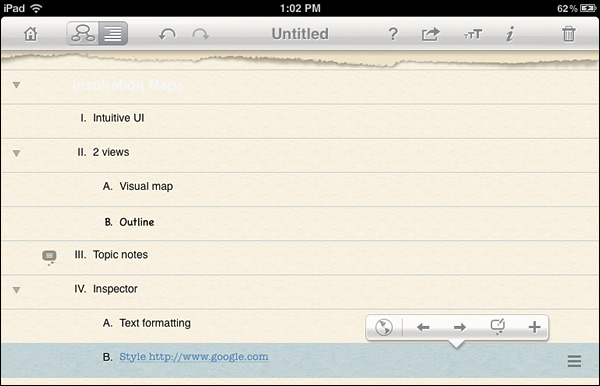Inspiration Software, a developer of mind mapping software for education and one of the pioneers of this type of program, has released an iPad app called Inspiration Maps. It offers a perfect set of features for teachers who want to incorporate visual thinking into their curricula, but it’s a little light weight for most business applications.
When you first open Inspiration Maps, you’re greeted with a template screen. Inspiration Maps gives you numerous templates to choose from. Many are educationally focused, but there are some business templates here as well, including:
- Cause and effect diagram
- Group project plan
- Root cause analysis
You can also create a blank diagram, without a template.
Creating a mind map in Inspiration Maps
Each topic in this app contains two buttons, located on alternate corners of the topic shape. The one in the upper left corner, which looks like a thought balloon, enables you to add notes to the topic via a bright yellow pop-over box – not the typical iPad dialog box – a welcome change! When you create a topic note, the button changes color from silver with a pencil to dark gray with document lines – a simple visual cue that it contains additional content. But it doesn’t scream for attention. It’s just right.
The other button, located in the lower right corner, looks like an arrow with a dotted line. Tapping on it creates a new sub-topic, joined with what looks like a hand-drawn connector line. Tapping once selects the sub-topic, while a double-tap enables you to type a name into it. This seems like extra work compared to most mind mapping apps I’ve reviewed. With other apps, when you create a new topic, the virtual keyboard pops up and you can immediately type a description into it. With Inspiration Maps, it takes an extra step.
Adjusting topic and map properties
You can change the properties of your map topics using an inspector button on the app’s toolbar. This opens a dialog box with tabs that enable you to change the topic shape (6 shapes are provided), the style of the topic (color, outline), topic text formatting and diagram-level settings (connector style, map background color). You can use a pinch gesture to manually resize a topic shape – nice!
One minor problem I ran into while editing a mind map is that sometimes I wanted to apply a style only to a single topic, but I inadvertently had several topics selected. That’s because the blue outline color Inspiration Maps uses to show that a topic is selected didn’t look much different on my iPad 1’s screen than the normal gray drop shadow color. Perhaps it’s more distinct on a newer iPad with the higher-resolution retina display, but I found it took a little getting used to on my “old” tablet.
You can also add images to your diagrams easily, Using any stored in the iPad’s photo library. This means you could use its built-in camera to shoot photos and then include them in your mind maps, useful in the classroom but I’m not sure how often it would be used in business applications. When you add an image, Inspiration Maps treats it as the topic shape, not as something you add to one. As with topic shapes, you can use a pinch gesture to resize images.
Brainstorming mode
One of my favorite features of Inspiration for PCs and Macs has always been its brainstorming mode, which lets you quickly add a series of ideas to your map, using only the keyboard and the Enter key. I’m pleased to see that the developer has included it in this iPad version, complete with the distinctive lightning bolt icon.
When you tap on the lightning bolt to enter brainstorming mode, a cloud appears over your map’s central topic (see the screen shot) and the virtual keyboard pops up. The “return” key changes into a “next” key, encouraging you to enter another idea. Each time you type and tap the “next” key, Inspiration Maps adds a new topic with the text you just typed. In this mode, the app doesn’t give you control over topic placement. It just creates room for each topic and places it on the screen. It’s up to you to arrange them the way you want after your brainstorming session.
In short, this operating mode is a very efficient way to add content to your maps quickly. I enjoyed working with it. I can easily see a business executive or a teacher, with their iPad connected to a projector, soliciting ideas from the people in the room, and then adding them quickly to the map on their iPad.
Outline view
Of course, Inspiration Maps has an outline view, just like its big brother on the desktop. This app displays a hierarchical view of your map against a tan looseleaf paper background. The layout is Spartan, but very functional. The left side of the screen displays arrow icons that can be used to expand and collapse the levels of your outline. If any topics have notes, the “filled thought balloon” icon is displayed to the left of the topic text.
When you tap on a topic to select it in outline view, a control bar pops up that enables you to indent or outdent it one level. A plus icon enables you to quickly add a new topic at the same level of your outline. And a globe icon enables you to navigate any hypertext links in your topics. Tapping on a link opens the iPad’s Safari browser and takes you to that URL.
On the far right of the workspace is a drag icon that enables you to move topics up and down the outline. This design is very smart, because it actually prevents you from accidentally dragging an outline topic to a different location in the outline.
Exporting
Inspiration Maps gives you a number of options for sharing your maps:
- You can send them via e-mail
- Save them as images to your photos folder
- You can print them, using the iPad’s AirPrint capability
- You can store and share your maps on Dropbox and iTunes
If you’re outlining a writing project (a common application for Inspiration in schools), you can export your map or outline to word processing apps, such as Pages. On my iPad, iA Writer, DocstoGo and iThoughtsHD also showed up on the export menu.
The one thing Inspiration Maps doesn’t do right now is produce a file format that the desktop version of Inspiration can open and edit. I tried this with a map I created on my iPad. After exporting it to my Dropbox account, tried to open it with Inspiration 9 on my PC, but it gave me an error message.
This isn’t surprising, considering that Inspiration 9 was developed prior to the iPad version. Presumably, the desktop version of the program would need to be compatible with the output of the iPad app, so it can properly interpret its file format and ignore any unsupported features. Perhaps in Inspiration 10? I’m not sure if this would be a priority for the developer, considering that they are completely focused on the education market.
Conclusion
This is a very attractive, easy to use mind mapping and outlining app. As one of the pioners in the mind mapping space, I’ve always had the deepest respect for Inspiration Software. So I Was very excited when I heard that they were working on an iPad app. It’s perfectly designed for the education market, but is perhaps a bit too light weight for business applications – especially considering that in most cases, you’re going to want to create a map on your iPad and then utilize its content in other software, such as a Word document or PowerPoint presentation.
Still, Inspiration Maps is an impressive debut. I can’t wait to see what the developer does with it in the coming months and years. It should be great.
The app is available in two versions: Inspiration Maps Lite is free, but limits you to creating only 5 mind maps and doesn’t support file sharing with other apps or online file storage services. The full version costs US$14.99. Both versions are available in the Apple AppStore.




Leave a Reply